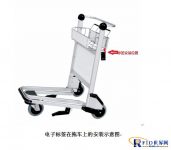
XX Airport RFID Solution
[ad_1]
1.1 Project background
Facing the competition of the information society, the airport, as the hub of all countries, is also a symbol of the strength of the country’s information technology. Only by continuously improving and perfecting airport management technology can we keep up with the international pace. The radio frequency identification technology —RFID is a new high-tech, and its advanced nature has already possessed the ability to replace the old generation of identification technology. RFID technology has attracted the attention of countries all over the world, and it will be put into airport management in a brand-new attitude to solve the heavy airport management problems!
After on-site surveys at the airport and feedback from airport staff, we found that the airport has two major annoying problems, that is, the management of passengers’ luggage and trolleys for pushing luggage.
1.11 Description of specific status
A. Trolley: At present, the collection, sorting, and fixed-point homing of passenger trolleys in the airport terminal mostly use traditional manual statistical management mode. Due to the wide distribution of the airport space and the large flow of people, the management of trolleys is difficult and information collection is difficult;
(1) Trolleys may accumulate in a large amount in a certain free area or a certain exit, but passengers who need to use trolleys in other areas cannot get the vehicle, and cannot provide convenient services to passengers.
(2) The traditional manual inspection method is used to allocate vehicles. The vehicles that can be collected and called by the man can only be the vehicles within his line of sight each time. This working method is labor intensive, and the efficiency of dispatching vehicles is very low. It is necessary to check the stacking situation of the trolleys every time when each post is inspected.
(3) Tens of thousands of trolleys in the airport circulate in various areas. With the traditional nameplate identification method, the trolleys can only be numbered and managed before the trolleys are put into use. When the trolleys are put into use, all trolleys must be managed. Statistical management is simply impossible. That is to say, the management method of nameplate marking can play a very limited role in actual work, and the loss and damage of vehicles cannot be timely and effectively supervised in place.
B. Baggage: In recent years, the air transport service industry has continued to expand rapidly, and airports in various places are also trying to improve work efficiency in order to provide as fast as possible services. Obviously, under normal circumstances, it is not an easy task to provide satisfactory services to the daily operations of hundreds of airplanes and a large number of passengers in terms of convenience and safety. At least it is more than what the general public looks like from the surface. Much harder. Some large-scale international airports in China, such as Hongqiao International Airport, cover an area of 8.2 square kilometers. There are thousands of luggage lockers belonging to different airlines, and hundreds of transport vehicles, trolleys and other frequently move back and forth from various areas. Device and so on. To make it run smoothly, the airport needs to design an efficient and sophisticated planning and logistics system, and rely on a large amount of manpower, material resources and specialized equipment to make it run smoothly and orderly. In this case, special transportation vehicles and luggage are often misplaced or lost, and additional manpower is required to find these assets or provide a written report to the manager to coordinate the use of resources in various aspects. Of course, if the coordination here is not smooth, it will cause more misplacement and loss events, and even fall into a vicious circle, which is extremely detrimental to the airport management authority. Looking at the experience of airport logistics management at home and abroad, for any intelligent system (technology) that wants to solve the above problems, the following four functions are indispensable:
(1) It is very convenient to find luggage lockers and transportation equipment;
(2) Any delay in finding important assets for flight preparation purposes can be eliminated in time;
(3) Avoid the additional burden of manual search;
(4) The remote control of related logistics can be achieved.




[ad_2]



